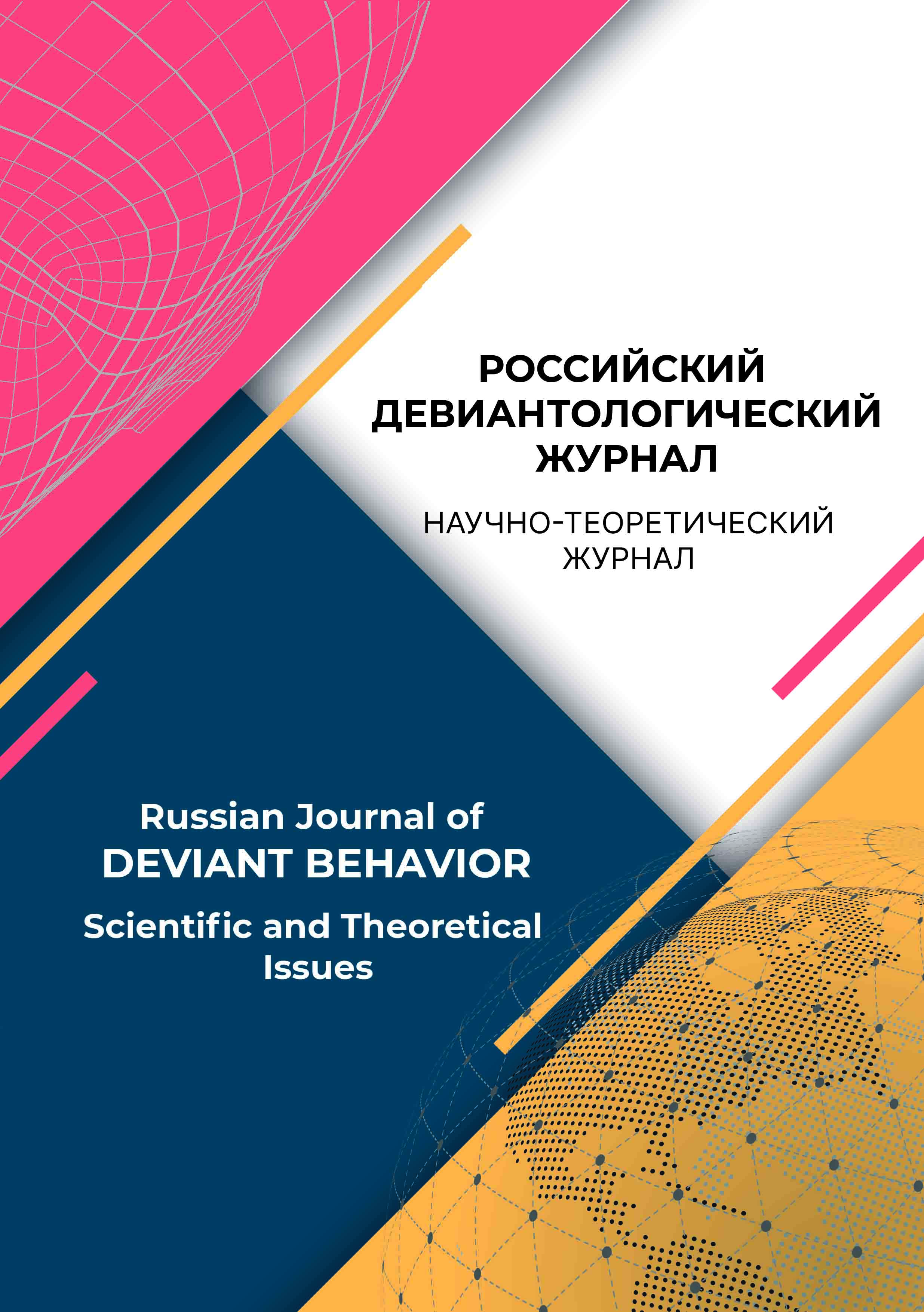from 01.01.2016 until now
Russian Federation
from 01.01.2016 until now
Russian Federation
Russian Federation
Russian Federation
The process of digitalization, creating conditions for the formation of new types of addictions - digital addictions, has transformed the existing mechanisms for the dissemination of chemical forms of addictive behavior. Changes in the forms, methods and varieties of psychoactive substances (PS) and behavioral models actualize the need for a deep understanding of the causes of this phenomenon and the definition of markers for its manifestation. The complexity of the preventive diagnosis of addictive behavior raises the question of using new, fundamentally different mechanisms for obtaining information. The oculography (or eyetracking) method has the necessary qualities, which allows you to determine the hidden intentions of a person by analyzing his oculomotor activity. The purpose of the study is to determine the diagnostic capabilities of the eye-tracking method in identifying a tendency to addictive behavior. The study was conducted as part of a laboratory experiment using the Tobii Pro Spectrum eyetracker by demonstrating the stimulus material “search for words in the fieldword”. The experiment tested the hypothesis of confirming the experience of using drugs, tobacco-containing substances and alcohol among young people on the basis of the psychophysiological data obtained as a result of eye-tracking. As a result of the study, it was found that the subjects do not show statistically significant differences in the search for neutral and trigger stimuli in the «Alcoholism» group, but they notice and read neutral words in the «Drug addiction» group more often. The conducted experiment allows us to state that the oculography method has diagnostic capabilities in relation to identifying markers of addictive behavior in the group of drug use. The continuation of experimental research in this direction seems promising and in demand, since the use of the psychophysiological methodincreases the reliability of the data obtained, minimizes the factor of social desirability and optimizes the diagnostic procedure itself.
addictive behavior, markers of addictive behavior, diagnostics, psychophysiological method, eye-tracking method, oculography method
1. Bessonova, Yu. V., Oboznov, A. A. (2019). Ajtreking v diagnostike pravdy-lzhi. Institut psihologii Rossijskoj akademii nauk. Organizacionnaya psihologiya i psihologiya truda. 4(1), 46-86. EDN ZDDJGP.
2. Buhtiyarov, I. V., Zhbankova, O. V., Yushkova, O. I., Gusev, V. B. (2019). Novye psihofiziologicheskie podhody, primenyaemye pri profotbore kandidatov v opasnye professii. Medicina truda i promyshlennaya ekologiya, (3), 132-141. https://doi.org/10.31089/1026-9428-2019-3-132-141. EDN ZBBKKL.
3. Egorov, A. Yu. (2020). Nekhimicheskie (povedencheskie) addikcii: voprosy tipologii, diagnostiki i klassifikacii. Voprosy narkologii, 4(187), 7-23. https://doi.org/10.47877/0234-0623_2020_4_7. EDN JKXZWR.
4. Zhbankova, O. V., Gusev, V. B. (2018). Primenenie ajtrekinga v praktike professional’nogo otbora kadrov. Eksperimental’naya psihologiya, 11(1), 156-165 https://doi.org/10.17759/exppsy.2018110109
5. Ignatovskij, Ya. R., Ivanov, V. G. (2020). Ajtreking: potencial dlya primeneniya v gosudarstvennom upravlenii, politicheskom brendinge i planirovanii izbiratel’nyh kampanij. Vestnik Rossijskogo universiteta druzhby narodov. Seriya: Gosudarstvennoe i municipal’noe upravlenie, 7(2), 155-160. https://doi.org/10.22363/2312-8313-2020-7-2-155- 160. EDN GZUDFU.
6. Kloktunova, N. A., Solov’eva, V. A., Barsukova, M. I., Kuz’min, A. M. (2019). Izuchenie kognitivnyh processov obuchayushchihsya pri poiske obrazovatel’noj informacii na ekrane. Perspektivy Nauki i Obrazovaniya, 3(39), 326-340. https://doi.org/10.32744/pse.2019.3.25
7. Kompaniec, V. S., Lyz’, A. E. (2017). Ergodizajn pol’zovatel’skogo interfejsa: metody yuzabiliti-issledovanij. Inzhenernyj vestnik Dona, 3(46), 56-62. EDN ZWZESZ.
8. Kochetkov, N. V. (2020). Internet-zavisimost’ i zavisimost’ ot komp’yuternyh igr v trudah otechestvennyh psihologov. Social’naya psihologiya i obshchestvo, 11(1), 27-54. https://doi.org/10.17759/sps.2020110103. EDN IXEAEL.
9. Kulakov, S. A. (2003). Psihoterapiya i psihoprofilaktika addiktivnogo povedeniya u podrostkov. Moskow: Gardarika.
10. Lobachev, A. V., Nikol’skaya, S. A., Kornilova, A. A. (2017). Ajtreking v diagnostike psihicheskih rasstrojstv. Vestnik psihoterapii, 61(66), 98-112. EDN YJTWHX.
11. Lyashevskaya, O. N., Sharov, S. A. (2009). Chastotnyj slovar’ sovremennogo russkogo yazyka (na materialah Nacional’nogo korpusa russkogo yazyka). Moskow: Azbukovnik.
12. Mentyukova, M. A., Pustovalova, O. S. (2022). Sovremennaya narkoticheskaya situaciya kak kriminogennyj faktor rosta prestupnosti. Pravo: istoriya i sovremennost’, 6 (1), 119-127. https://doi.org/10.17277/pravo.2022.01. pp.119-127. EDN MWXTCZ.
13. Smirnov, A. V., Simonova, I. A., Popp, I. A., Maksimova, L. A. (2022). Psihometricheskij analiz rezul’tatov primeneniya v Rossijskoj Federacii edinoj metodiki social’no-psihologicheskogo testirovaniya nesovershennoletnih. Science for Education Today, 12(1), 7-28. https://doi.org/10.15293/2658-6762.2201.01. EDN RZYEHV.
14. Stupina, S. A. (2022). Nekotorye pokazateli sovremennoj narkoprestupnosti i ezhegodnogo monitoringa narkosituacii v Rossijskoj Federacii. Epoha nauki, 29, 93-103. EDN YBTMWK.
15. Chernyavskaya, V. S., Panchenko, L. L. (2019). Psihodiagnosticheskie vozmozhnosti ajtrekinga i perspektivy ispol’zovaniya metoda okulografii v obuchenii psihologov. Azimut nauchnyh issledovanij: pedagogika i psihologiya, 2(27), 400-402. https://doi.org/10.26140/anip-2019-0802-0089
16. Yacyk, G. G. (2016). K voprosu ob izuchenii okulomotornogo povedeniya cheloveka v situacii sokrytiya znachimoj informacii. Severo-Kavkazskij psihologicheskij vestnik, 14(1), 43-47. EDN WYKCID.
17. Brown, R. I. F. (1993). Some contributions of the study of gambling to the study of other addictions. In W. R. Eadington, J. A. Cornelius (Eds.), Gambling behavior and problem gambling (pp. 241-272). Reno: University of Nevada Press.
18. Donovan, D. M., Bigelow, G. E., Brigham, G. S., Carroll, K. M., Cohen, A. J., Gardin, J. G., Hamilton, J. A., Huestis, M. A., Hughes, J. R., Lindblad, R., Marlatt, G. A., Preston, K. L., Selzer, J. A., Somoza, E. C., Wakim, P. G., & Wells, E. A. (2012). Primary outcome indices in illicit drug dependence treatment research: systematic approach to selection and measurement of drug use end-points in clinical trials. Addiction, 107(4), 694-708. https://doi.org/10.1111/ j.1360-0443.2011.03473.x
19. Marks, I. (1990), Behavioural (non-chemical) addictions. British Journal of Addiction, 85(11), 1389-1394. https://doi. org/10.1111/j.1360-0443.1990.tb01618.x
20. Stockings E, & Degenhardt L. (2020). All-Cause and Cause-Specific Mortality Among People Using Extramedical Opioids: A Systematic Review and Meta-analysis. JAMA Psychiatry, 77(5), 493-502. https://doi.org/10.1001/jamapsychia¬try.2019.4170. PMID: 31876906; PMCID: PMC6990804.
21. Xin, M., Xing, J., Pengfei, W., Houru, L., Mengcheng, W., & Hong, Z. (2018). Online activities, prevalence of Internet ad¬diction and risk factors related to family and school among adolescents in China. Addictive Behaviors Reports, 7, 14-18. https://doi.org/10.1016/j.abrep.2017.10.003














